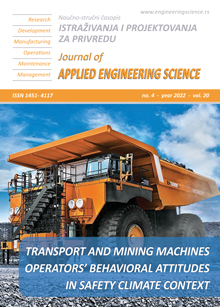SIMULATION OF TURBULENT FLOW IN A TWO-STROKE GRAIL ENGINE CYLINDER
Abstract
This paper investigates the implementation of computational fluid dynamics for the analysis of a grail internal combustion engine. This is intended to analyse the intake hole and channel shape variables as well as their corresponding influence on the fluid flow properties within the cylinder. Due to the geometry of the engine design which features an intake valve positioned directly on the piston, the combustion efficiency is therefore heavily dependent on the flow characteristics. This necessitates the need to understand and analyse the effects of intake hole and duct geometry as well as piston motion on flow dynamics. A numerical simulation using Autodesk CFD finite element solver was used to simulate the engine flow dynamics of the Grail engine. The results of the analysis show a violent tornado-like effect in the flow field as well as an observable swirl effect characterized by a cylinder-centred single vortex. The resultant flow field obtainable from the design of the Grain engines will therefore allow an ideal homogeneous/stoichiometric fuel-air mixture for increased combustion efficiency. The result of both 3-D static and dynamic simulations of the flow through the engine provided guidelines on the selection of several geometrical parameters for optimal performance. The pressure inside the cylinder of the Grail Engine is validated with the experimental setup. The values of TKE obtained from the numerical simulation are well within the limits obtained from the references.
References
S. A. Syed, “Numerical simulation of turbulent flow inside the cylinder of a new two-stroke grail engine design,” PhD Thesis, Wichita State University, 2015.
“US Patent Application for Two-stroke engine Patent Application (Application #20110036313 issued February 17, 2011) - Justia Patents Search.” https://patents.justia.com/patent/20110036313 (accessed May 30, 2022).
R. B. Lechner, “Modelling of the combustion parameters of biogenous fuel gases to predict stable combustion conditions in multifuel systems,” PhD Thesis, University of Birmingham, 2020.
A. K. Agarwal, S. Gadekar, and A. P. Singh, “In-cylinder air-flow characteristics of different intake port geometries using tomographic PIV,” Physics of Fluids, vol. 29, no. 9, p. 095104, 2017.
B. MuraliKrishna and J. M. Mallikarjuna, “Effect of engine speed on in-cylinder tumble flows in a motored internal combustion engine - An experimental investigation using particle image velocimetry,” Journal of Applied Fluid Mechanics, 2011, doi: 10.36884/jafm.4.01.11895.
Y. Li, H. Zhao, Z. Peng, and N. Ladommatos, “Particle image velocimetry measurement of in-cylinder flow in internal combustion engines - Experiment and flow structure analysis,” Proceedings of the Institution of Mechanical Engineers, Part D: Journal of Automobile Engineering, 2002, doi: 10.1243/0954407021528913.
K. M. Rahman, N. Kawahara, D. Matsunaga, E. Tomita, Y. Takagi, and Y. Mihara, “Local fuel concentration measurement through spark-induced breakdown spectroscopy in a direct-injection hydrogen spark-ignition engine,” International Journal of Hydrogen Energy, vol. 41, no. 32, pp. 14283–14292, 2016.
M. R. Abdulwahab, Y. H. Ali, F. J. Habeeb, A. A. Borhana, A. M. Abdelrhman, and S. M. A. Al-Obaidi, “A review in particle image velocimetry techniques (developments and applications),” Journal of Advanced Research in Fluid Mechanics and Thermal Sciences, vol. 65, no. 2, pp. 213–229, 2020.
김명수, “Development of a Comprehensive 0D Model for an SI Engine Based on the Analysis of the Kinetic Energy of Tumble and the Critical Factors for Flame Wrinkling,” PhD Thesis, 서울대학교 대학원, 2022.
J. T. Ilić, S. S. Ristić, and M. Ž. Srećković, “Laser doppler velocimetry and confined flows,” Thermal Science, vol. 21, no. suppl. 3, pp. 825–836, 2017.
A. O. Ojo, B. Fond, C. Abram, B. G. Van Wachem, A. L. Heyes, and F. Beyrau, “Thermographic laser Doppler velocimetry using the phase-shifted luminescence of BAM: Eu 2+ phosphor particles for thermometry,” Optics express, vol. 25, no. 10, pp. 11833–11843, 2017.
F. Payri, J. Benajes, X. Margot, and A. Gil, “CFD modeling of the in-cylinder flow in direct-injection Diesel engines,” Computers and Fluids, 2004, doi: 10.1016/j.compfluid.2003.09.003.
J. B.Heywood, Internal Combustion Engine Fundamentals Second Edition. 2015.
K. Kuwahara and H. Ando, “Diagnostics of in-cylinder flow, mixing and combustion in gasoline engines,” Measurement Science and Technology. 2000. doi: 10.1088/0957-0233/11/6/202.
A. A. Verbeek, T. W. Bouten, G. G. Stoffels, B. J. Geurts, and T. H. van der Meer, “Fractal turbulence enhancing low-swirl combustion,” Combustion and Flame, vol. 162, no. 1, pp. 129–143, 2015.
K. Pan and J. Wallace, “Soot and combustion models for direct-injection natural gas engines,” International Journal of Engine Research, vol. 23, no. 1, pp. 150–166, 2022.
R. K. Maurya and P. Mishra, “Parametric investigation on combustion and emissions characteristics of a dual fuel (natural gas port injection and diesel pilot injection) engine using 0-D SRM and 3D CFD approach,” Fuel, vol. 210, pp. 900–913, 2017.
F. J. Laimböck, G. Meister, and S. Grilc, “CFD application in compact engine development,” 1998. doi: 10.4271/982016.
H. Hori, T. Ogawa, and T. Kuriyama, “CFD in-cylinder flow simulation of an engine and flow visualization,” 1995. doi: 10.4271/950288.
P. Ramaswamy, V. Shankar, V. R. Reghu, N. Mathew, and S. M. Kumar, “A model to predict the influence of inconsistencies in thermal barrier coating (TBC) thicknesses in pistons of IC engines,” Materials Today: Proceedings, vol. 5, no. 5, pp. 12623–12631, 2018.
A. Siddique, S. A. Azeez, and R. Mohammed, “Simulation And CFD Analysis of Various Combustion Chamber Geometry of A CI Engine Using CFX,” Simulation, vol. 5, no. 8, pp. 33–39, 2016.
S. J. Kazmouz, Large-Eddy Simulations of Motored Flow and Combustion in a Stratified-Charge Direct-Injection Spark-Ignition Engine. The Pennsylvania State University, 2020.
“Discretization Method | CFD | Autodesk Knowledge Network.” https://knowledge.autodesk.com/support/cfd/learn-explore/caas/CloudHelp/cloudhelp/2014/ENU/SimCFD/files/GUID-DEE0664D-771B-4446-9ED4-1498267D13FB-htm.html (accessed Apr. 25, 2021).
“General Fluid Flow and Heat Transfer Equations | CFD | Autodesk Knowledge Network.” https://knowledge.autodesk.com/support/cfd/learn-explore/caas/CloudHelp/cloudhelp/2014/ENU/SimCFD/files/GUID-83A92AE5-0E9E-4E2D-B61F-64B3696E5F66-htm.html (accessed Apr. 25, 2021).
B. E. LAUNDER and D. B. SPALDING, “THE NUMERICAL COMPUTATION OF TURBULENT FLOWS,” in Numerical Prediction of Flow, Heat Transfer, Turbulence and Combustion, 1983. doi: 10.1016/b978-0-08-030937-8.50016-7.

